Italian cuisine is very regional. Italy has 20 regions that are further subdivided into 107 provinces. The provinces are usually named after the main city or town. Each province is proud of its culinary tradition and has its own piatti tipici (typical dishes). Sometimes they are very similar to dishes of nearby provinces, but usually there are differences as well. In some cases the dishes are even more local, with differences within the same province. For instance, Viareggio and Camaiore are both towns in the same province of Lucca in the region of Tuscany. However, scarpaccia (zucchini cake) is sweet in Viareggio and savory in Camaiore. There is an even a word in the Italian language to describe pride in one’s own town, which is campanilismo (which comes from the word campanile or bell tower, and refers to the attachment to the town’s bell tower). This goes even a bit further, because many families have their own versions of the regional typical dishes with minor variations, are very proud of those, and will insist it is the best version of the dish (like nonna used to make it). As a consequence, inside of Italy, there is no such thing as “Italian cuisine”.
Italian restaurants outside of Italy usually have dishes from all over Italy on their menu, like Vitello Tonnato from Piemonte, Spaghetti alla Carbonara from Rome, Tagliatelle al Ragù Bolognese from Bologna, and Ossobuco alla Milanese from Milan. Restaurants outside of Italy usually serve good authentic dishes if their owners were born in Italy, even if they have recipes from all over Italy on their menus. But when you are in Italy, beware of restaurants with dishes on the menu from outside of the region! Those are usually tourist traps (I have not encountered a single exception yet). A good restaurant is proud of the culinary tradition of the region and will have only regional dishes on the menu. Each region has enough delicious dishes to fill the menu. Another good way to tell a good Italian restaurant from a bad one is to check whether there is cream in the Carbonara (which there should not be) or what pasta shape the Bolognese ragù is served on (should not be spaghetti but tagliatelle, preferably fresh). “Spaghetti alla Bolognese” does not exist in the city of Bologna. (Spaghetti al ragù if you see it outside of Emilia-Romagna is fine, and that ragù can be quite similar to Bolognese, but it should not be called alla Bolognese if it is served with spaghetti.) An exception is when a chef from a region opens a restaurant in another region in Italy with dishes from his home region, like Ligurian restaurant Del Ponte in Milan. To an Italian from Milan that is a bit like going to a ‘foreign’ restaurant.
Personally I have visited all regions of Italy and have prepared dishes from all regions, which is something most Italians have not done. At home Italians will often cook regional dishes as well, and they may not always be familiar with dishes from other regions. Of course all Italians know the famous dishes from other regions like the ones I mentioned above that are served in Italian restaurants outside of Italy, but when I was in a kitchen equipment store in Rome and asked about Troccoli, the typical pasta shape of the province of Foggia in Puglia, the shopkeeper did not have a clue what I was talking about. Thanks to immigration within Italy, many Italians prepare dishes from different regions, because their parents or grandparents originally came from there. Like my blogging friend Bea who has Sicilian roots and lives in Lombardia but prepares both Lombardian and Sicilian dishes, or my blogging friend Paola who is from Liguria and prepares dishes from Liguria, but also lives in Lombardia.
Each region and sometimes province also has its own pasta shapes. Ravioli are called agnolotti in Piemonte and tortelli or tortellini in Emilia-Romagna. But the province of Parma within the region of Emilia-Romagna has its own ravioli called Anolini.

This has been a very long introduction to end up with today’s recipe, which is Tordelli al Ragù, also called Tordelli alla Lucchese. Tordelli is the name for ravioli from the province of Lucca in the region of Tuscany. They are round and are stuffed with meat, and often they are served with a meat and tomato ragù. If you are in a restaurant in the province of Lucca, tordelli should be on the menu. The name tordelli is of course very close to tortelli from the nearby region of Emilia-Romagna, and also the filling and ragù are quite similar to tortellini al ragù from that region (but don’t say that to someone from Lucca or Emilia-Romagna, because they will react as if you have lost your mind).
Making fresh ravioli is always a lot of work, but always worth it. Certainly true in this case as well. Making not only ravioli but also ragù adds to that. Of course you can make more of the ragù and freeze it to serve over pici or pappardelle (both pasta shapes from Tuscany).
Ingredients

For 6-8 servings as primo piatto (makes about 72 tordelli)
For the tordelli
- Fresh pasta dough from about 300 grams (2 cups) Italian 00 flour and 3 eggs
- 200 grams (7 oz) beef
- 150 grams (5 oz) pork
- 75 grams (3 oz) mortadella, chopped
- 1 Tbsp fresh thyme leaves
- 4 fresh sage leaves
- 1 sprig of fresh rosemary
- 1 egg
- 75 grams (3 oz) stale white bread without crust, diced
- 80 ml (1/3 cup) milk
- 60 ml (1/4 cup) meat stock (brodo di carne)
- 60 ml (1/4 cup) red wine
- 50 grams (2 oz) freshly grated parmigiano reggiano
- 2 Tbsp olive oil
- salt and freshly ground black pepper
- 1/8 tsp ground cinnamon
- 1/8 tsp freshly ground nutmeg
For the ragù
- 200 grams (7 oz) ground beef
- 200 grams (7 oz) ground pork
- 300 grams (10.5 oz) canned tomatoes, pureed
- 1 carrot, minced
- 1 celery stalk, minced
- 1 red onion, minced
- 2 bay leaves, preferably fresh
- 1 Tbsp tomato concentrate (tomato paste)
- 240 ml (1 cup) meat stock (brodo di carne)
- 120 ml (1/2 cup) red wine
- 4 Tbsp olive oil
- salt and freshly ground black pepper
- 1/8 tsp ground cinnamon
- 1/8 tsp ground cloves
- 1/8 tsp freshly ground nutmeg
To serve
- freshly grated parmigiano reggiano
Instructions
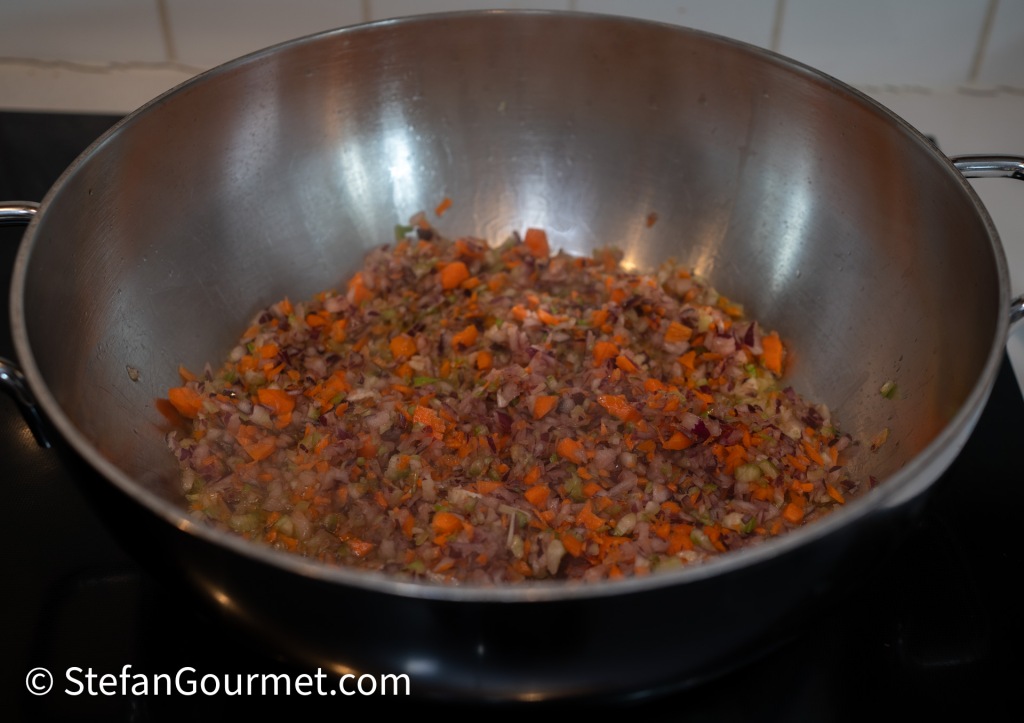
To make the ragù, heat 2 tablespoons of olive oil in a casserole, add the minced onion, carrot, and celery, and stir over medium-high heat…

…until the vegetables have browned somewhat.
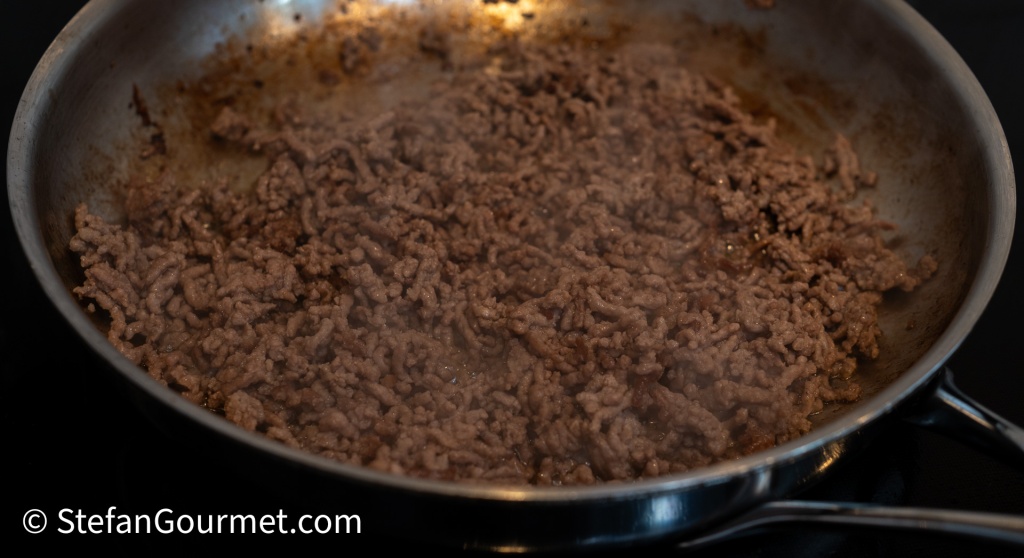
In the meantime, in a separate frying pan, heat 2 tablespoons of olive oil and brown 200 grams of ground beef and 200 grams of ground pork over high heat, stirring constantly with wooden spatulas to break up the meat, until the meat is nicely browned. Most Italian recipes will tell you to brown the meat with the vegetables, but it will brown better on its own.

When the vegetables have browned somewhat, add 2 bay leaves and a tablespoon of tomato paste, and stir for a minute longer.

Deglaze with 60 ml red wine, and stir until most the wine has evaporated.

Add 300 grams of pureed canned tomatoes. Season with salt and freshly ground black pepper, 1/8 teaspoon of cinnamon, and 1/8 teaspoon of freshly grated nutmeg…
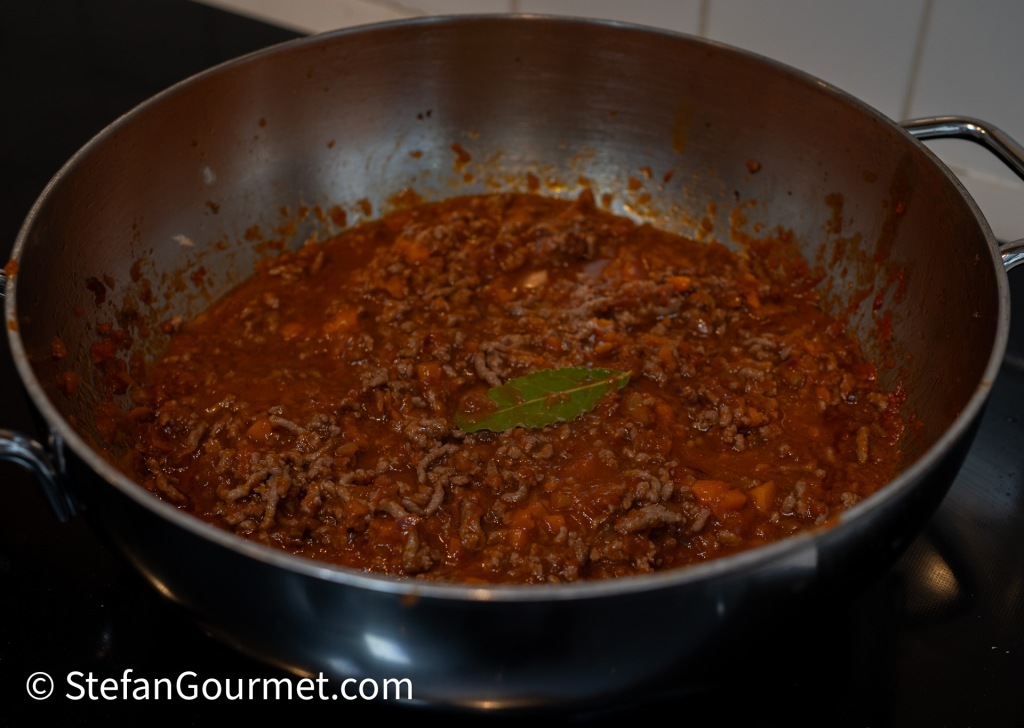
…and add the browned meat. Deglaze the frying pan in which you browned the meat with some water, and scrape with a wooden spatula to release all the flavor that got stuck, and add that to the casserole with the ragù as well. Add meat stock to cover the meat, stir, and bring the casserole to a very slow simmer.
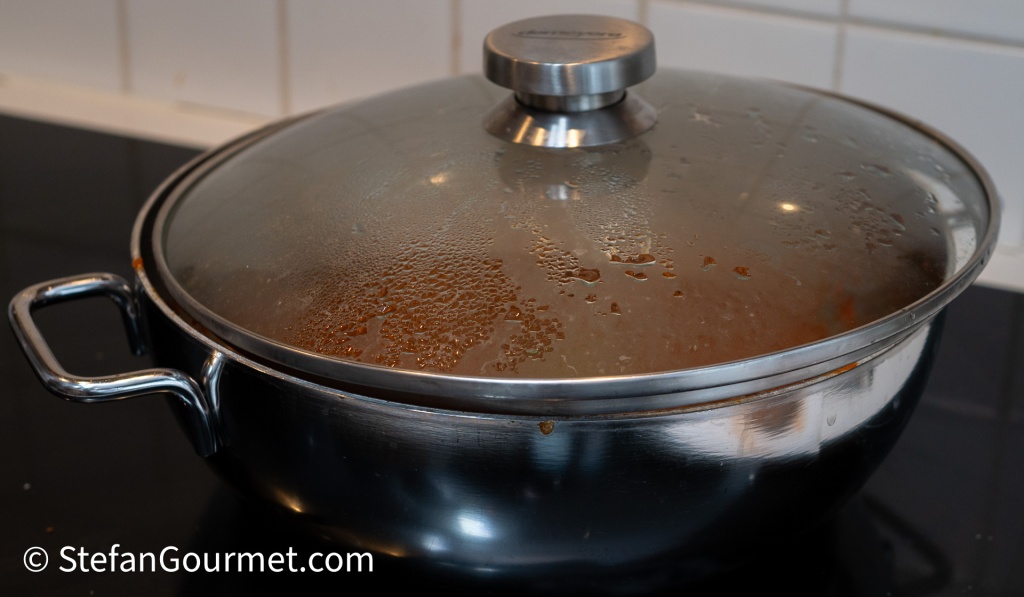
Cover and simmer over very low heat, stirring once in a while, for about 3 hours. There should only be an occasional bubble. Add a bit of water or meat stock if it becomes too dry.

The ragù should become thick and very flavorful. Taste and adjust the seasoning with salt and freshly ground black pepper.

To make the filling, brown the beef and pork in two tablespoons of olive oil with the rosemary and sage over high heat. It is easiest to brown the meat if it is cut into steaks, not diced.

Make sure the meat is nicely browned, because browning means flavor.

When the meat is nicely browned on both sides, deglaze with 60 ml of red wine. Allow half of the wine to evaporate, stirring to release any flavor stuck to the pan.
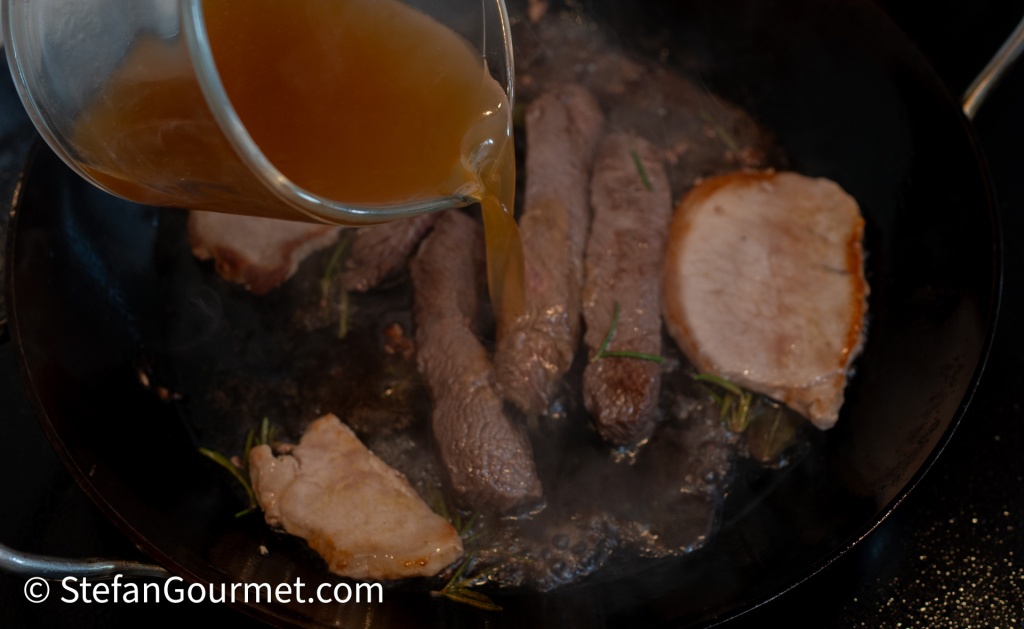
Then add 60 ml of meat stock.
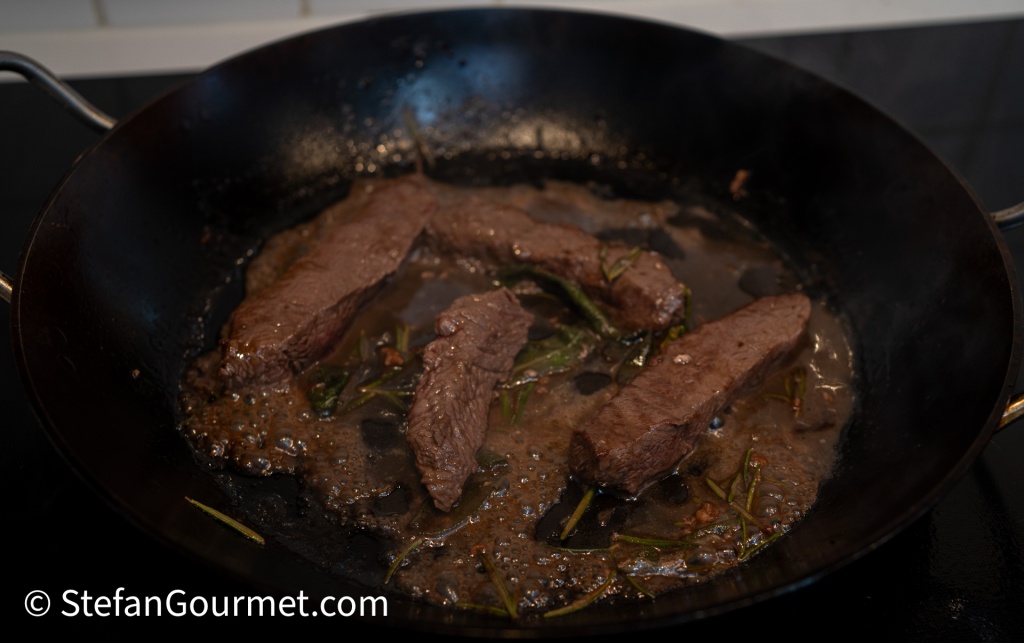
Finish cooking the meat over low heat. I had taken out the pork before the beef, as the pork was sliced more thinly and was already cooked through. Discard the rosemary and sage, but reserve the pan juices.

Dice the pork and the beef. (As you can see in the photo, the beef was still pink on the inside.)

Allow 75 grams of crustless diced stale bread to soak with 60 ml of milk. When the bread has become soft, squeeze out the milk and add the bread to the bowl of the food processor.
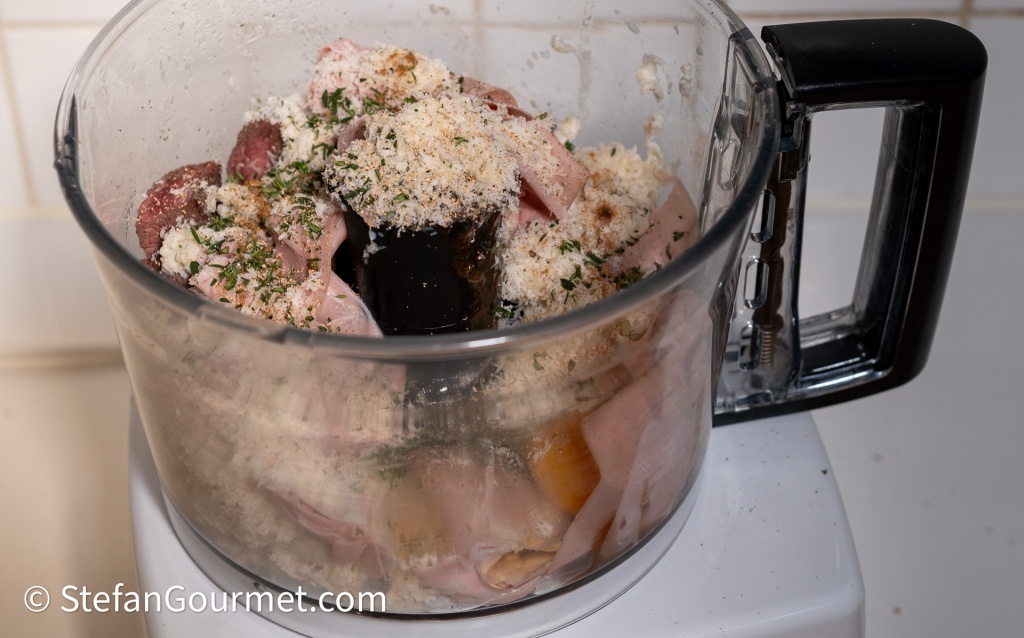
Add the diced pork, diced beef, 75 grams chopped mortadella, 1 Tbsp fresh thyme leaves, 1 egg, 50 grams freshly grated parmigiano reggiano, 1/8 tsp ground cinnamon, and 1/8 tsp freshly ground nutmeg.
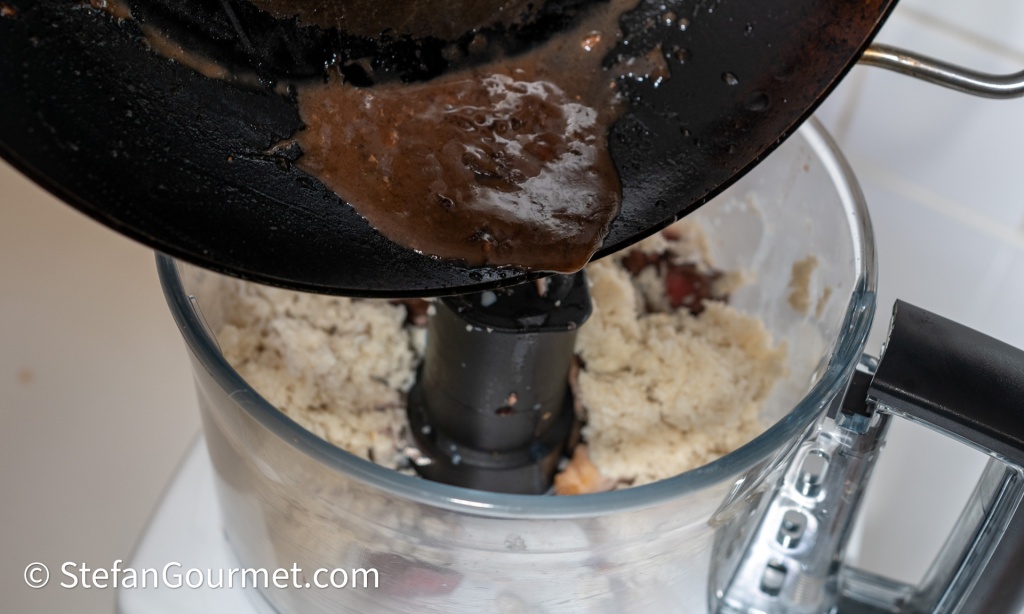
Add the reserved pan juices from the browning the meat.

Use the “pulse” until the filling is uniformly chopped and mixed, but not completely pureed. Scrape down the sides of the bowl with a spatula as needed.
Taste and adjust the seasoning of the filling with salt and freshly ground black pepper. (If you do not want to taste the filling raw because it has egg in it, you can briefly cook it in the microwave.) As always with ravioli, add more seasoning then you think it needs when you taste the filling without the pasta.
The filling should be moist. If it is too dry, add a bit of meat stock. If it is too wet, add a bit of breadcrumbs.

Place the filling in a bowl, cover, and allow to firm up in the refrigerator for at least half an hour.
Make fresh pasta dough using these instructions from 300 grams flour and 3 eggs, wrap it in plastic film, and allow to rest in the refrigerator for at least half an hour.

Roll out the pasta as thinly as possible and make round ravioli with a diameter of 5 cm (2 inches) using my instructions for making ravioli. It is easier and quicker to make regular rectangular ravioli and they will taste the same, but then you can’t call them tordelli.

When the ragù is ready and you are ready to serve, bring a large pot of salted water to a boil, and boil the ravioli for 2 minutes only.

When they are cooked, lift them out of the pot with a strainer, and add them to the ragù.

Gently toss the tordelli with the ragù using wooden or rubber spatulas without breaking them.

Serve the tordelli on preheated plates, sprinkled with freshly grated parmigiano reggiano.
Wine pairing
This is very nice with a medium-bodied Chianti.
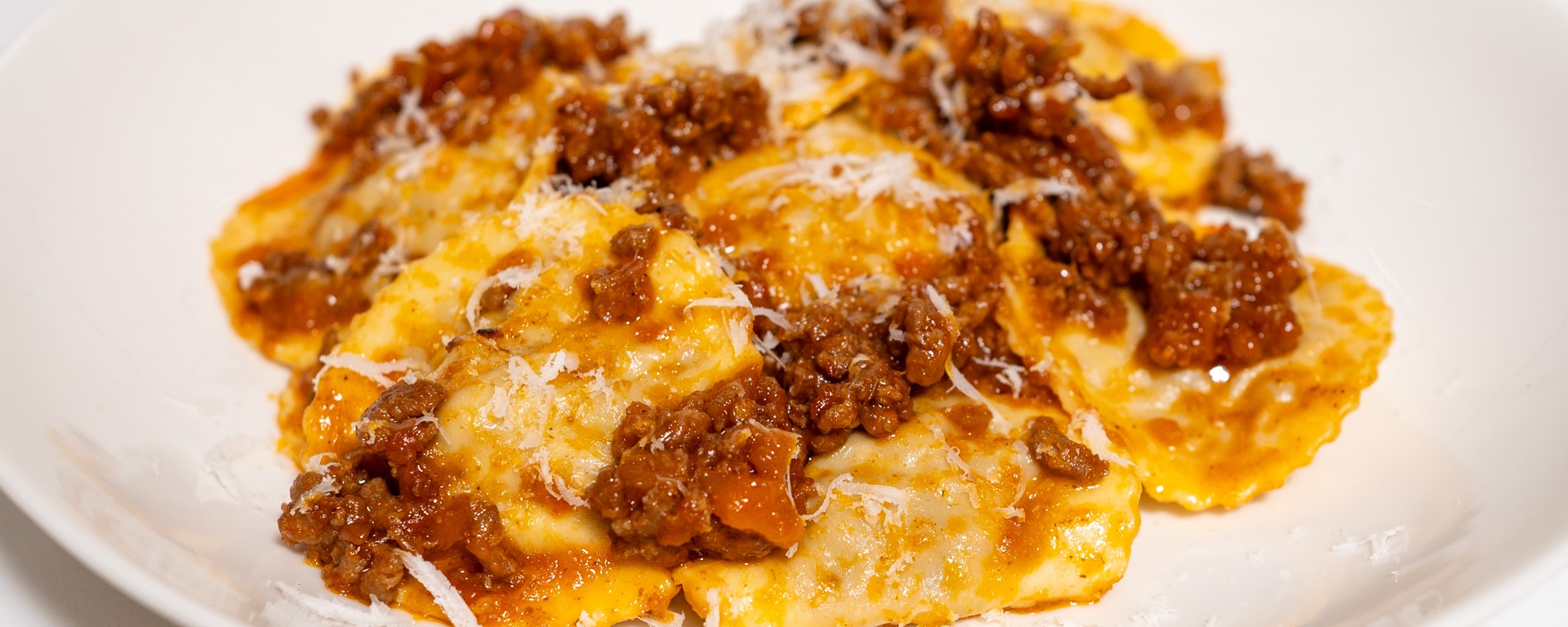

A great introduction and some great tips! I’ve never browned meat before grinding I don’t think but it makes sense when it’s ending up as filling. Beautiful.
LikeLiked by 1 person
Thanks Mimi. Most Italian ravioli filling recipes with meat will tell you to brown or even braise the meat before mincing it.
LikeLike
It’s always worth the effort to make pasta from scratch, and it’s fun! This looks like a most memorable dish.
LikeLiked by 1 person
Steve,
How do I leave a comet, I’m confused…I’m a chef.
Here is my comment.
Steve,
I have been following you for 10 years and I don’t believe I have made any comments. Today I finally have time so, my Mother-in-law is from bagni di lucca Italy and makes them the way except they are tortellacci.
Now that I have time I will try and make some of your meals. FYI I am a retired Italian chef. (Really started out as a home chef and opened a closed-door restaurant in Cape Cod, Massachusetts. I did farm to table from my garden, local farms, plenty of fresh fish and everything from scratch. We had 5-9 courses every week, not making the same thing twice (unless to improve), Also every week it was based on a festival in Italy and their food. Also 20 years ago I took a course in the science of food at Harvard and started doing molecular gastronomy.
As time progressed, I opened a full time Restaurant, and my menu was taken from the best dishes of the past. Appetizers were mostly molecular, Pasta Traditional with a twist (example instead of grated parmesan cheese, it was Parmesan Foam), entree both, and dessert all molecular.
Thank you for all your hard work and doing what you do!
I look forward to reading all that I have saved and what you do in the future.
Frank Tammaro
LikeLiked by 1 person
Excellent, I will be in Lucca 2 weeks from now!
LikeLiked by 1 person
Thank you for a fabulous local recipe I shall follow every step of the way. Thank you more for taking the time for your factual explanation of what real Italian food is and how it should be presented! Priceless !!! When I think of past ‘problems’ being disbelieved and ‘laughed’ at regarding ‘spaghetti Bolognese’ alone !!!!
LikeLiked by 1 person
Complimenti, quasi quasi li faccio per Natale. Ma soprattutto, grazie del bellissimo ricordo! Noi vi aspettiamo sempre 🙂
LikeLiked by 2 people
Ma per Natale tu fai i tortelli al ragù alla Bolognese? Oppure proprio quelli toscani?
LikeLike
In genere faccio i tortellini con la ricetta della mia famiglia (che non è quella classica), ma mi piacerebbe cambiare qualche volta
LikeLiked by 1 person
I can just imagine how tasty this dish is as I’ve had your Ravioli before. It’s definitely worth the effort to make your own pasta, so tender and delicate. This dish comes at the perfect time when the weather is turning nippy and we begin to crave warming dishes.
LikeLiked by 2 people
Ciao Stefan, ma che ricetta favolosa e descritta, come al solito, con grande professionalità. Grazie per avermi fatto ricordare la splendida serata trascorsa da me. Se tornerai penso che ti farò la pasta alla norma. Un grazie anche per avermi fatto scoprire i Tordelli. Pensavo fosse un errore di battitura ed invece esistono davvero. Un abbraccio grandissimo 😉
LikeLiked by 2 people